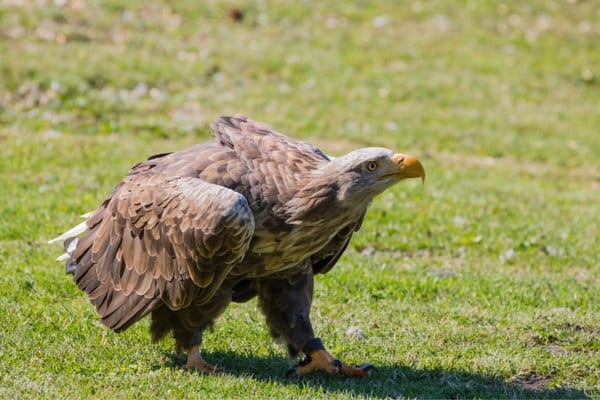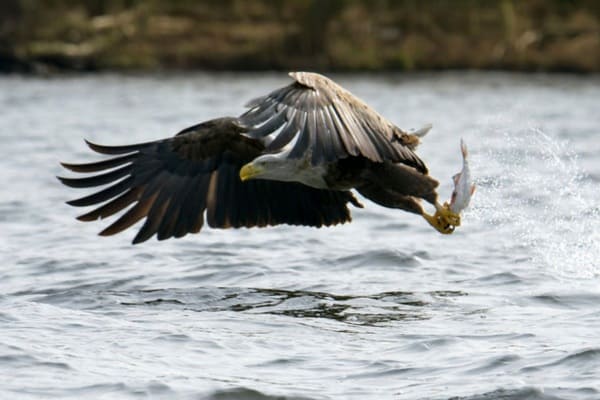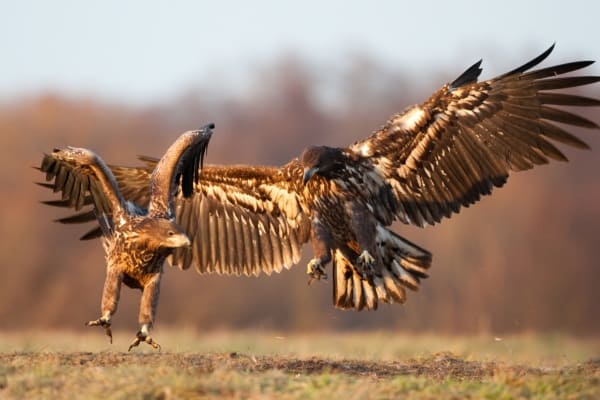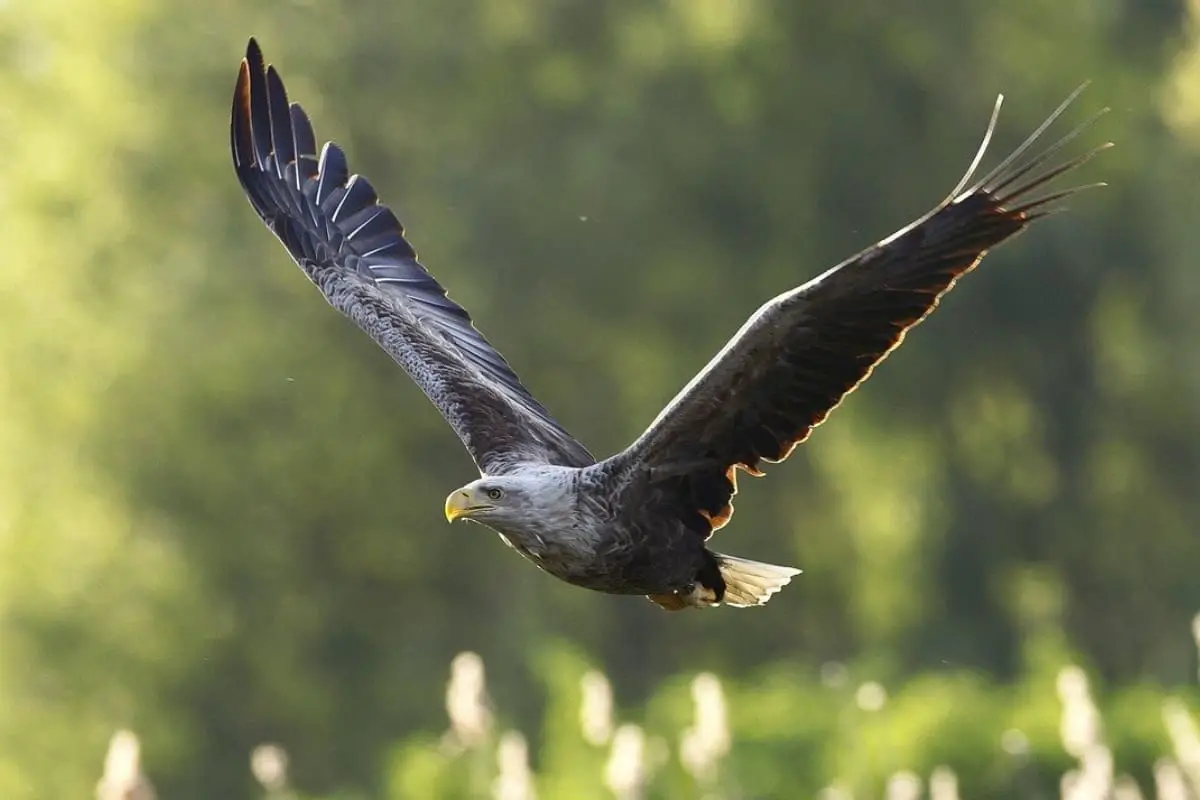Common Name: White-tailed Eagle
Scientific Name: Haliaeetus albicilla| Size | Diet | Range in Hawaii | Status in Hawaii |
|---|---|---|---|
| 27 in. - 37 in. | salmon, trout, and other freshwater fish | Kaua'i and Ni'ihau | Least Concern |
The White-tailed Eagle (Haliaeetus albicilla) is a majestic bird of prey that has captured the imagination of people for centuries. With its impressive wingspan and piercing gaze, this eagle is a symbol of power and grace. While it is native to Europe and Asia, it has also been spotted in Hawaii, making for a rare and exciting sighting for birdwatchers on the islands.
In this article, we’ll delve into the fascinating world of the White-tailed Eagle and explore its unexpected presence in Hawaii. From its impressive hunting skills to its unique adaptations, we’ll uncover the secrets of this magnificent bird and learn more about its journey to the Hawaiian islands.
White-tailed Eagle
Appearance

The White-tailed Eagle is a magnificent bird of prey known for its large size and striking appearance. With a wingspan ranging from 6 to 8 feet (1.8 to 2.4 meters) and a length of 26 to 37 inches (66 to 94 cm), it is one of the largest eagle species in the world.
This majestic bird features a predominantly brown plumage, accentuated by a distinctive white tail that gives it its name. Its head and neck exhibit a pale coloring, varying from white to yellowish-brown, adding to its regal appearance. The White-tailed Eagle possesses a robust hooked beak, which is pale yellow and serves as a formidable tool for capturing and consuming prey.
Its piercing yellow eyes and strong talons further contribute to its commanding presence. While juvenile White-tailed Eagles have a darker overall appearance with mottled brown feathers and a lack of the characteristic white tail, they gradually acquire the adult coloring as they mature.
The White-tailed Eagle’s size, impressive wingspan, distinctive brown and white plumage, hooked beak, and piercing yellow eyes make it an awe-inspiring sight in its natural habitat.
Diet
The White-tailed Eagle has a varied and opportunistic diet that primarily consists of fish. As a skilled fisherman, it often hunts by soaring high above bodies of water and then diving down to snatch fish from the surface with its sharp talons.
Its preferred fish species include salmon, trout, and other freshwater and marine fish. However, the White-tailed Eagle is also known to scavenge and feed on carrion, such as dead animals or fish carcasses, particularly during the winter months when food may be scarce.
Additionally, it may prey on small mammals, waterfowl, seabirds, and even young deer when the opportunity arises. The White-tailed Eagle’s diet reflects its adaptability and ability to exploit various food sources within its habitat, making it a versatile and opportunistic predator.
Nesting
The White-tailed Eagle constructs large and sturdy nests for breeding. These nests, known as eyries, are typically built on tall trees or rocky cliffs near bodies of water, offering a vantage point for hunting and observing the surroundings. The eyries are often substantial structures, reaching sizes of several feet in diameter and weighing hundreds of kilograms.
The eagles add new materials to the nest each year, such as sticks, twigs, and vegetation, gradually expanding and reinforcing it over time. The nesting season usually begins in early spring, with the female laying one to three eggs. Both the male and female take part in incubating the eggs, which lasts for about 35 to 45 days.
Once the chicks hatch, they are cared for by both parents, who provide them with food and protection. The young eagles remain in the nest for around three months, developing their flight feathers and honing their hunting skills. White-tailed Eagles tend to be faithful to their nest sites, often reusing the same eyrie in subsequent breeding seasons, making their nests an essential part of their reproductive behavior and life cycle.
Behavior

The White-tailed Eagle exhibits a range of behaviors that are characteristic of its species. As a powerful and skilled predator, it is often observed soaring high in the sky, utilizing its impressive wingspan and keen eyesight to scan the surroundings for potential prey. The White-tailed Eagle is primarily a solitary bird, although it may gather in loose groups near abundant food sources or during the breeding season. It is known for its territorial nature, fiercely defending its hunting grounds and nesting sites from intruders.
When hunting, the White-tailed Eagle employs a variety of techniques. It may engage in aerial pursuits, diving from great heights to snatch fish from the water’s surface or swooping down to capture small mammals or birds. The eagle also demonstrates opportunistic feeding behavior, scavenging on carrion or stealing food from other predators, such as Ospreys or other eagles.
During courtship and breeding, the White-tailed Eagle engages in impressive aerial displays, involving swooping flights, talon clasping, and calling to attract a mate. Once a pair bonds, they become monogamous and establish a strong partnership, working together to build and maintain their nest, incubate the eggs, and raise their young.
White-tailed Eagles are known for their characteristic “mewing” call, which is often heard during their territorial displays or interactions with other individuals. These birds also engage in occasional territorial disputes, with dramatic aerial confrontations between rival eagles.
Habitat
The White-tailed Eagle is a species that thrives in diverse habitats, primarily those with access to large bodies of water. It is commonly found in coastal regions, estuaries, lakes, rivers, and wetlands. These eagles are often associated with areas that offer an abundant supply of fish, their preferred prey.
The White-tailed Eagle’s habitat typically includes a combination of water, forested areas, and open spaces. It requires mature trees or cliffs for nesting, which provide a vantage point for hunting and breeding. The proximity to water bodies is crucial as it provides the eagles with a consistent food source and an environment suitable for their hunting strategies.
The presence of undisturbed areas and limited human disturbance is also important for the White-tailed Eagle’s habitat. They prefer habitats with minimal human encroachment, allowing them to establish and defend their territories and nests without disturbance. These pristine habitats often offer a diverse array of prey species and ensure the overall ecological balance necessary for the eagle’s survival.
In some regions, the White-tailed Eagle may also utilize artificial structures such as power line poles or artificial platforms as alternative nesting sites, especially in areas where suitable natural nesting sites are scarce.
Range
The White-tailed Eagle is not native to Hawaii and is not a regular resident species in the Hawaiian Islands. However, there have been documented sightings of a single adult White-tailed Eagle on Kaua’i and potentially on Ni’ihau, two of the Hawaiian Islands.
hese sightings occurred from December 2006 to May 2007, suggesting an individual bird exploring or temporarily visiting the islands. The range of the White-tailed Eagle typically encompasses northern Europe, Russia, and parts of Asia. Its occurrence in Hawaii is considered rare and exceptional, as the species is not known to have a established population or breeding presence in the Hawaiian Islands.
Conservation Status

The White-tailed Eagle is now listed as a species of “Least Concern” on the International Union for Conservation of Nature (IUCN) Red List. In some regions, such as Europe, the population has rebounded significantly, and the species has been successfully reintroduced in areas where it had disappeared.
Ongoing conservation efforts focus on maintaining suitable habitats, protecting nesting sites, and ensuring sustainable fishing practices to preserve the eagle’s primary food source. Additionally, public awareness campaigns promote responsible environmental practices to minimize disturbance to nesting eagles and their habitats.
Interesting Facts
1. Iconic appearance
This majestic eagle is known for its striking appearance, featuring a brown plumage, a distinctive white tail, and a large, powerful beak and talons
2. Apex predators
As top predators in their ecosystems, White-tailed Eagles play a vital role in maintaining the ecological balance. They are known to prey on a variety of animals, including fish, waterfowl, seabirds, and small mammals.
3. Impressive flight displays
During courtship and territorial displays, White-tailed Eagles engage in breathtaking aerial acrobatics, including impressive dives, swoops, and talon clasping, showcasing their agility and strength.
4. Scavenging behavior
In addition to hunting, White-tailed Eagles are opportunistic scavengers, often feeding on carrion and taking advantage of available food sources, especially during the winter months.
Frequently Asked Questions
1. Are White-tailed Eagles territorial?
Yes, White-tailed Eagles are territorial birds. They fiercely defend their hunting grounds and nesting sites from intruders, especially during the breeding season.
2. How long do White-tailed Eagles live?
White-tailed Eagles can live up to 25 to 30 years in the wild, although some individuals have been known to live even longer.
3. Are White-tailed Eagles solitary birds?
While White-tailed Eagles are generally solitary birds, they can be seen in pairs during the breeding season when they form long-term partnerships. However, outside of the breeding season, they may interact with other eagles in feeding areas or when defending their territories.
4. Are White-tailed Eagles known for their vocalizations?
Yes, White-tailed Eagles have a variety of vocalizations, including high-pitched calls, screams, and barks. They use these vocalizations for communication, territory defense, and during courtship displays.




